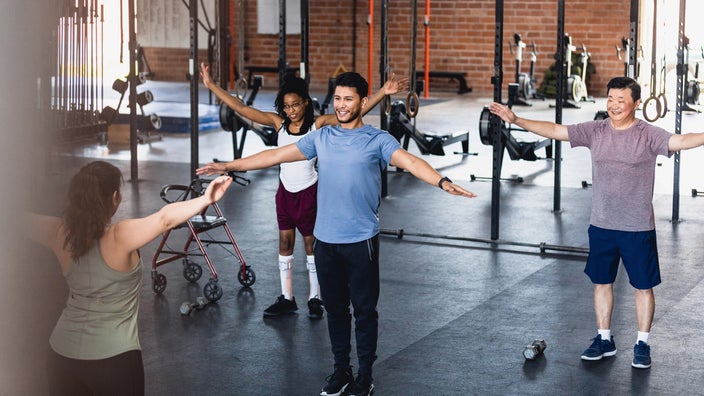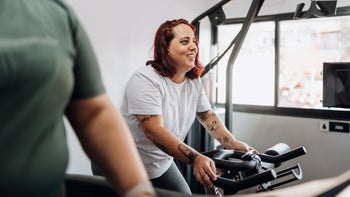
7 Shoulder Mobility Exercises and Stretches for Better Range of Motion
Key takeaways:
A stiff shoulder can make everyday activities, like getting dressed or washing your hair, difficult and painful.
Arthritis, frozen shoulder, or rotator cuff injury often cause poor shoulder mobility.
Shoulder stretches, along with rotator cuff and scapular strengthening exercises, may improve shoulder mobility and decrease pain.

If your arm feels stiff during activities like reaching overhead to put on a shirt or reaching behind to fasten a bra, you might have limited shoulder mobility. Tight or inflexible muscles can make it difficult to move your joint, which causes less mobility. Sometimes, you may have normal muscle flexibility but reduced mobility due to other issues, such as tightness in the joint capsule.
Shoulder mobility exercises can help with pain-free movement and daily functioning. Targeted moves may improve your range of motion and flexibility, lessen pain and tension, and help prevent injury.
What are the best shoulder mobility exercises and stretches?
Before we delve into the best shoulder mobility exercises, let's note the difference between mobility and flexibility. Mobility allows you to move your shoulder through its full range of motion. For example, if you can lift your arm overhead or easily reach behind you, you have full mobility. Flexibility is the ability of your muscles to lengthen, such as when you do a doorway stretch.
Search and compare options
Both are important for healthy joints and muscles. And you probably already know that stretching helps boost flexibility and range of motion. But a 2021 meta-analysis found that strengthening exercises are just as effective as stretches in improving mobility.
In another review, researchers looked at physical therapy exercises for shoulder pain. They focused on three types of training: shoulder mobility, rotator cuff strengthening, and scapular (shoulder blade) stability. All three decreased pain, increased range of motion, and improved function.
Research also suggests that doing certain stretches at specific points in your exercise routine is essential. Start with dynamic or active movements to warm up your shoulder muscles. Then, move on to shoulder strengthening exercises. End your shoulder mobility exercise routine with passive or static stretches to improve your range of motion.
Try these shoulder mobility exercises — preferably in this order — with your healthcare provider's OK. Stop if you feel any sharp pains.
1. Large arm circles
Large arm circles are a dynamic exercise that helps loosen the shoulder joint and muscles. The move may boost circulation and improve range of motion.
Step 1: Stand tall with your feet shoulder-width apart and your shoulders back.
Step 2: Extend your arms overhead, keeping your palms facing forward and your elbows straight.
Step 3: Lower your arms out to your sides and then down to the starting position to make a full circle.
Step 4: Complete 10 forward arm circles. Then reverse the movement to repeat in the opposite direction.
Step 5: Make sure you take your arm through its complete range of motion.
Read more like this
Explore these related articles, suggested for readers like you.
2. Overhead resistance band roll
The overhead resistance band roll requires a long, stretchy resistance band. This dynamic exercise engages upper back muscles and helps move your shoulder joint through a range of motion.
Step 1: Stand with your back straight and your feet shoulder-width apart.
Step 2: Place your hands on the ends of a light resistance band and hold it in front of you with your arms straight at shoulder level.
Step 3: Keep your arms straight as you move them over your head.
Step 4: Continue moving the band behind your head, taking your arms in a backward circle. Go back as far as you can in a pain-free range of motion.
Step 5: Reverse the movement, bringing the band forward until it rests on your hips.
Step 6: Repeat the movement 10 to 20 times.
3. Standing row
The standing row works the scapular muscles that pull your shoulders back. It also engages the lat muscles, which run from the mid to lower back. The strengthening exercise can keep your shoulders in a neutral position to avoid slouching, shoulder impingement, or other injuries that affect mobility. You can use a resistance band with handles or a cable machine at the gym for this move.
Step 1: Tie a resistance band around a door hinge or other sturdy object so you have two ends to hold onto. The band should be a height somewhere between your belly button and the bottom of your chest.
Step 2: Stand 2 to 3 feet from the door with one foot in front of the other. Keep your back straight and your shoulders back as you grasp the ends of the band.
Step 3: Pull the band toward you, keeping your elbows close to your sides and your forearms parallel to the floor.
Step 4: Squeeze your shoulder blades together and hold briefly.
Step 5: Release the hold as you move your arms straight in front, returning to the starting position.
Step 6: Do 2 to 3 sets of 15 reps.
4. Wall angel
The wall angel exercise targets upper and lower back muscles for spinal mobility. It can strengthen scapular muscles, including the rotator cuff. And it can help you work on external range of motion in the shoulder joint and stretch tight chest muscles. Wall angels are one of many great posture exercises for people who sit or slouch a lot.
Step 1: Stand with your back against the wall, knees bent, and feet about 4 or 5 in away. Keep your head, shoulders, back, and bottom against the wall.
Step 2: Bend your elbows out to the sides, keeping them level with your head. Try to keep the backs of your hands and forearms against the wall. If you can't, keep them as close to the wall as you can without sharp pains. As your mobility improves, you will be able to touch the wall.
Step 3: Keep your hands and forearms against (or close to) the wall as you slowly move your arms down until your hands align with your head.
Step 4: Slowly extend your arms over your head, keeping your hands and forearms in contact with the wall.
Step 5: Do 2 to 3 sets of 10 reps.
5. Internal and external shoulder rotation with weight
The American Academy of Orthopaedic Surgeons recommends internal and external shoulder rotation to strengthen the muscles that support your shoulders. The movement can build rotator cuff strength and improve shoulder joint mobility.
You will need a small, 1 to 2-lb dumbbell or weighted plate. The weight should be heavy enough to make the last reps difficult but not painful. You can increase the weight bit by bit as you get stronger. Consider adding other rotator cuff exercises to your routine as well.
Step 1: Lie on your back with your knees bent and your feet flat on the floor.
Step 2: Extend your left arm straight at shoulder level. Hold a dumbbell in your right hand, and place your right arm out to the side, with your elbow bent to 90 degrees. Your right elbow should be on the floor and level with your shoulder. Your right hand should be up toward the ceiling with your palm facing forward while you hold the weight.
Step 3: Keep your elbow bent and on the floor as you slowly move your arm back. Lower the back of your hand to the floor or as close to it as you can.
Step 4: Slowly bring your arm forward until the front of the hand touches the floor. If you can't go all the way down, go as far as possible without sharp pain. Keep your shoulder on the ground and your elbow touching the ground throughout the arc of motion.
Step 5: Repeat 3 sets of 15 reps on each arm.
6. Sleeper stretch
The sleeper stretch may ease tension in the back of the shoulder, which improves mobility during internal rotation. This is helpful if shoulder tension makes it hard to do things like washing your back.
Step 1: Lie on your right side with your legs stacked on each other.
Step 2: Bring your right elbow out to the side at shoulder height, with your arm bent and your fingers pointed toward the ceiling.
Step 3: Place your left hand on the back of your right hand and gently push or guide it down to the floor. Keep your elbow on the floor, letting your arm rotate forward.
Step 4: Lower your arm as far as you can without sharp pain. You will feel a stretch in the back of your shoulder. Hold for 15 to 30 seconds.
Step 5: Repeat 3 times.
Step 6: Switch to the left side and repeat.
7. Doorway stretch
The doorway chest stretch is a passive movement that lengthens the chest muscles (pectoralis muscles). It can help keep the shoulder joint flexible and mobile during external rotation.
Step 1: Stand in a doorway and place the bottom of your forearm on the doorframe with your elbow bent at 90 degrees at shoulder height.
Step 2: Lean or step forward to feel a stretch along the front of your shoulder. You can also turn your head away from your arm for a more intense stretch.
Step 3: Hold for 15 to 30 seconds.
Step 4: Repeat 3 to 5 times before switching to the other arm.
Why is shoulder mobility important?
The shoulder moves in many directions, making it the most mobile joint in the body. It's critical for activities of daily living and functional movements like bathing, getting dressed, or putting items on a shelf overhead. Shoulder mobility is also helpful for exercise and hobbies like golf or tennis.
A mobile joint keeps the muscles loose and boosts circulation to all the soft tissues. Normal motion prevents muscle imbalances and lowers your chance of injury. Reduced shoulder mobility can affect your arm, neck, and back. The affected muscles can't work properly and may be weaker.
So, it's important to address a stiff shoulder before it becomes a more complicated injury. Talk to your healthcare provider if you have shoulder pain and reduced motion.
What causes poor shoulder mobility?
With most shoulder injuries, you will notice pain and a gradual drop in movement. You may also have trouble sleeping on that shoulder. Common causes of shoulder stiffness include:
Shoulder impingement, rotator cuff tears, or other injuries
Shoulder bursitis
Get immediate medical help if you can't move your arm after a fall or other traumatic injury. You should also get immediate medical care if you see signs of a stroke, such as sudden numbness or weakness in one arm, sudden change in the ability to speak, or facial droop.
The bottom line
A stiff, achy shoulder can make many daily activities difficult. So, it's important to get your provider's approval to start shoulder mobility exercises to improve the range of motion, maintain strength, and prevent muscle imbalances. Shoulder stretches and strengthening exercises can help you return to your usual, pain-free routine.
Why trust our experts?



References
[BackSpace] Chiropractic Fitness TV. (2015). How to do the Wall Angel for tight shoulders [video]. Youtube.
Afonso, J., et al. (2021). Strength training versus stretching for improving range of motion: A systematic review and meta-analysis. Healthcare.
American Council on Exercise. (n.d.). Standing row.
Beaumont Health. (n.d.). Shoulder mobility.
Center For Total Back Care. (2020). Doorway pec and shoulder stretch with Dr. Raz [video]. Youtube.
Chang, L., et al. (2022). Anatomy, shoulder and upper limb, glenohumeral joint. StatPearls.
EmergeOrtho-Triangle Region. (2014). Sleeper stretch [video]. Youtube.
Haley, J. (n.d.). The importance of flexibility and mobility. PennState Kinesiology.
Home Gym Fitness Channel. (2018). Standing back row using resistance band with door anchor [video]. Youtube.
Mezian, K., et al. (2022). Frozen shoulder. StatPearls.
Orillia Sports Medicine And Rehabilitation. (2015). Supine internal and external rotation shoulder mobilization. Youtube.
OrthoInfo. (2021). Arthritis of the shoulder. American Academy of Orthopaedic Surgeons.
OrthoInfo. (2021). Shoulder impingement/rotator cuff tendinitis. American Academy of Orthopaedic Surgeons.
OrthoInfo. (2022). Rotator cuff and shoulder conditioning program. American Academy of Orthopaedic Surgeons.
Page, P. (2012). Current concepts in muscle stretching for exercise and rehabilitation. International Journal of Sports Physical Therapy.
PhysiHub Library. (2018). Big Arm Circles [video]. Youtube.
Pieters, L., et al. (2020). An update of systematic reviews examining the effectiveness of conservative physical therapy interventions for subacromial shoulder pain. Journal of Orthopaedic & Sports Physical Therapy.
Tahran, Ö., et al. (2020). Effects of modified posterior shoulder stretching exercises on shoulder mobility, pain, and dysfunction in patients with subacromial impingement syndrome. Sports Health.
UC San Diego Health. (2022). Doorway pectoral stretch (flexibility).
WODFitters. (2018). Shoulder mobility exercises for overhead lifts using WODFitters resistance bands [video]. Youtube.





























